Sourced by Homes & Gardens: 15 Best Places to Buy a Bed Frame for the Most Stylish (and Comfortable) Night's Sleep
Looking for a new bed? Start here with our expert guide to help you find the perfect fit

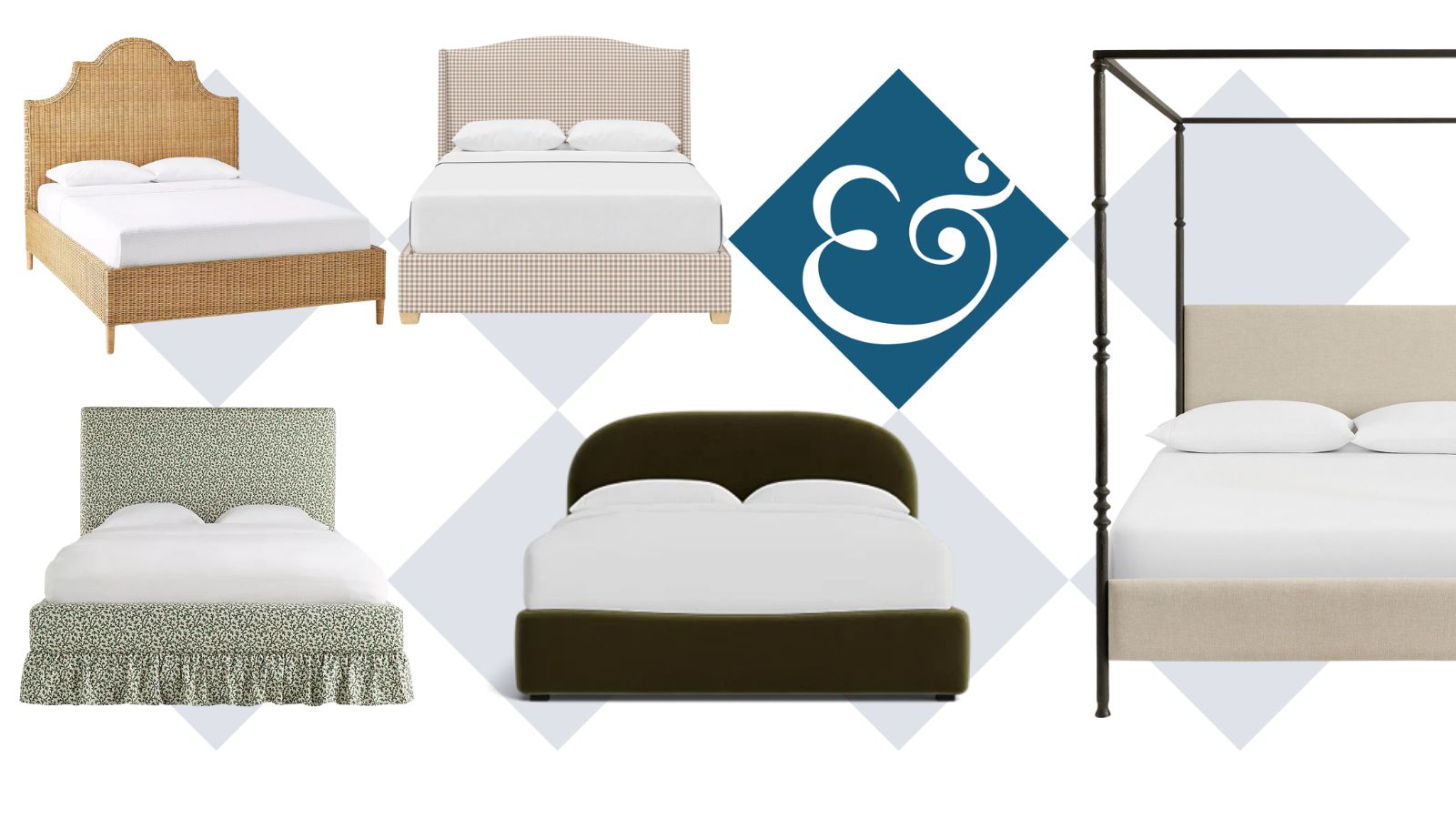
A bed frame is one of the most important pieces of furniture you’ll ever invest in. It anchors the room, sets the tone, and determines how comfortable – and serene – your sleep space feels each night. The right bed can instantly elevate a bedroom, whether you’re drawn to sculptural silhouettes, timeless solid-wood, or a stylish upholstered design.
Of course, there are many places to buy bedroom furniture, but choosing one can feel overwhelming. When it comes to choosing a bed there are countless materials and shapes to consider and a huge range of retailers now offering beautiful frames at every price point, so knowing where to start becomes the challenge.
Luckily for you, we've curated a guide to the most stylish, design-led, and reliable places to buy a bed frame – the stores and makers we genuinely trust for quality, craftsmanship, and lasting comfort. Each offers something different, whether you’re hunting for something handcrafted, a trend-led print, or an affordable upgrade.
Here, you'll find everything you need to know to help you find the perfect choice for your bedroom, divided up into categories: Luxury & Designer, Specialty Makers, and Affordable Finds.
Luxury & Designer Retailers
The furniture retailers are all about craftsmanship, luxury materials, and timeless design that you know will last for years. Here, you’ll find options for hardwood, custom upholstery, sculptural silhouettes, and meticulous detailing that elevate a bedroom instantly.
Pottery Barn

In this warm, cozy bedroom the Atwell Metal Canopy Bed has been softened with ochre hues and the Calista Embroidery Quilt, also from Pottery Barn.
Pottery Barn remains a go-to for classic, well-crafted bed frames that suit almost any interior style. Their collection spans timeless wooden sleigh beds, four-posters, upholstered designs, and versatile storage frames – all built with durability and everyday comfort in mind. With an emphasis on quality materials and customizable finishes, Pottery Barn makes it easy to create a bedroom that feels classic and cozy. The best part is that you can 'Shop by Room' to recreate their professionally-styled schemes.
Best for: Classic silhouettes, customizable finishes, and durable wood or upholstered frames
Lead time: Generally 2–4 weeks
Price: $$–$$$
Magnolia

Not only does the Blythe Slipcovered Bed look casual and comfortable, but the covers come off and are machine-washable - perfect for busy homes.
Magnolia brings Joanna Gaines’ signature modern farmhouse style and warmth to a small but thoughtful collection of bed frames. Expect clean lines, subtle textures, and vintage-inspired metal designs that work beautifully in both rustic and modern spaces. With styles designed to mix effortlessly with the rest of the Magnolia aesthetic, these beds make creating a cozy, collected bedroom wonderfully easy. The Corrine set is a best-seller.
Best for: Modern farmhouse silhouettes, approachable styles, and warm, welcoming finishes
Lead time: Typically 1–2 weeks for most in-stock styles
Price: $$
McGee & Co.

Seen here in this layered bedroom, the Peregrine Bed works wonders at adding natural texture and color to the scheme and pairs lovely with the bolder Mackenna Nightstand.
McGee & Co.’s signature blend of classic and laid-back style translates beautifully into their bed frame collection. Expect timeless silhouettes, solid wood, and softly upholstered designs that bring instant warmth and polish to a bedroom. Thoughtful details – from leather accents to subtle curves – give each piece that unmistakable Shea McGee touch. Take a peek at the McGee Icons page for her bestselling furniture designs.
Best for: Elevated styles, solid-wood frames, and refined upholstered designs
Lead time: Typically 5–10 business days for in-stock styles; longer for made-to-order pieces
Price: $$–$$$
Lulu and Georgia

Vintage earthy florals bring depth to this color-rich bedroom styled with the Courtet Platform Bed in Sage Linen paired with the Royce Wallpaper.
Lulu & Georgia is a favorite for design lovers seeking bed frames with a refined, fashion-forward edge. Their collection (and designer collaborations with the likes of Sarah Sherman Samuel) lean into sculptural silhouettes, rich upholstery, and fun textures – the kinds of pieces that instantly elevate a space. Whether you’re drawn to curved profiles, woven details, or statement bedroom colors, Lulu & Georgia offers thoughtfully designed beds that feel both current and timeless.
Best for: Trend-forward styles, luxe upholstery, and sculptural frames
Lead time: Usually 2–4 weeks; some made-to-order styles may vary
Price: $$–$$$
Serena & Lily
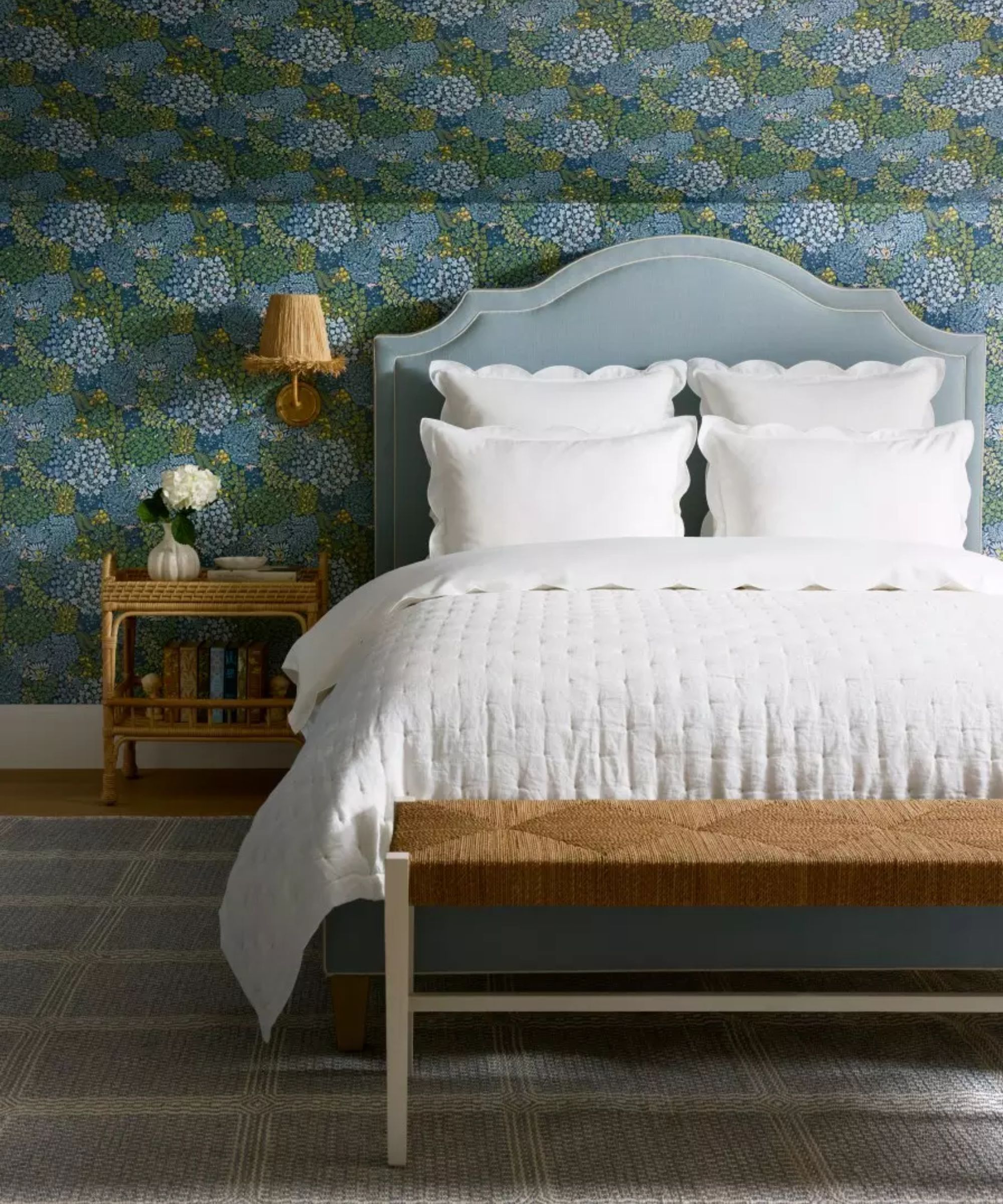
For a richer take on coastal, take inspiration from this cozy blue bedroom and choose the Loire Headboard in sky blue for your bedroom makeover.
Serena & Lily brings its breezy, coastal bedroom aesthetic to a curated selection of bed frames that feel light, fresh, and polished. Think airy rattan, crisp blue and white upholstery, and beautifully crafted wood designs. These beds are perfect for creating a serene, vacation-at-home feel while still offering the quality and craftsmanship Serena & Lily is known for. Try their 'Shop by Room' inspiration hub for a full breakdown of their stylish and serene bedroom schemes.
Best for: Coastal design, rattan and woven textures, and crisp, tailored upholstery
Lead time: Typically 1–3 weeks for in-stock pieces
Price: $$–$$$
West Elm
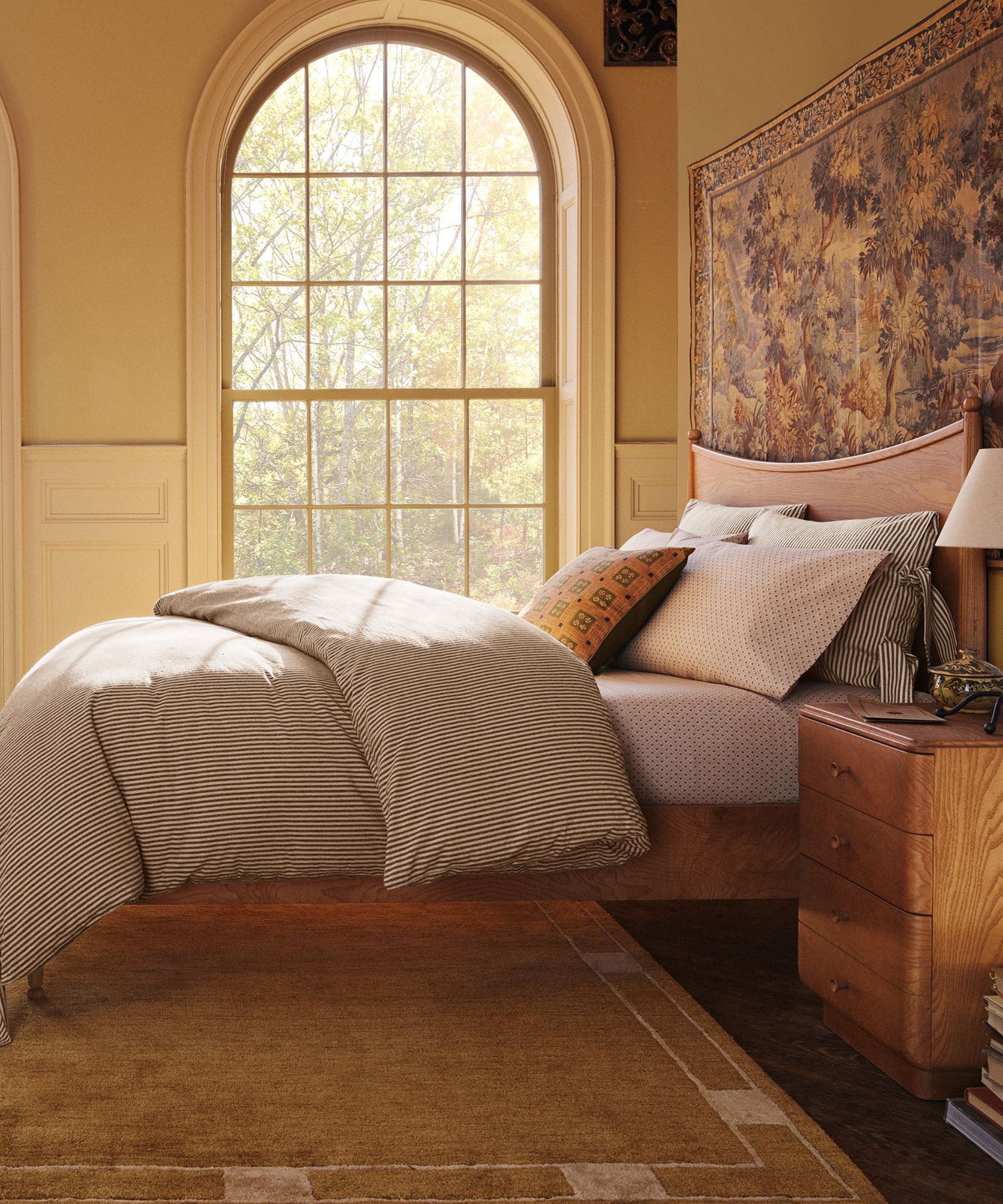
Designed as part of the beloved Pierce & Ward collaboration, the Curved Burl Wood Bed is a timeless-with-a-twist piece that you'll love forever.
West Elm offers a modern, design-forward selection of bed frames that balance clean lines with quality craftsmanship. From mid-century silhouettes in FSC-certified wood to upholstered frames with thoughtful detailing, their beds feel fresh, functional, and tailored to contemporary living. With a wide range of finishes and materials, plus frequent new drops, West Elm makes it easy to find a stylish piece to suit any bedroom. The Mid-Century Bedroom Collection is a fan favorite.
Best for: Modern and mid-century styles, sustainable wood options, and versatile upholstered frames
Lead time: Generally 1–3 weeks for in-stock items
Price: $$
Crate & Barrel

The Keane Solid Driftwood King Bed and matching storage pieces go from classic to trendy with this palette of moody browns and deep greens.
Crate & Barrel delivers bed frames that combine modern sophistication with exceptional quality. Their collection spans tailored upholstered designs, sleek metal frames, and solid-wood beds crafted with refined, architectural lines. With an emphasis on durability and understated elegance, Crate & Barrel beds bring a polished, contemporary feel to any primary or guest bedroom. Don't sleep on Crate & Kids, too, for more whimsical pieces that also work in grown-up spaces.
Best for: Clean, contemporary silhouettes and high-quality craftsmanship
Lead time: Typically 1–3 weeks for most in-stock styles
Price: $$–$$$
Anthropologie

Update a boring bed base with the Gia Francois Tapestry Headboard from Anthropologie that adds serious romance to your sleep space.
If you're shopping for bed frames to make a statement, head to Anthropologie. Anthropologie is a dream destination for anyone who loves color, pattern, and truly distinctive design. Their bed frames offer carved wood details, hand-applied finishes, romantic curves, and textiles you won’t find anywhere else. Many pieces are created in collaboration with artisans or crafted in small batches, giving each bed a sense of personality and charm with the bonus of White Glove delivery. While matching sets might be outdated, at Anthropologie, pattern-drenched furniture like the Hattie collection is the height of fashion.
Best for: Artistic, one-of-a-kind silhouettes, bold upholstery, and pattern-rich designs
Lead time: Typically 2–6 weeks, depending on availability
Price: $$–$$$
Specialty Makers
Specialty makers deliver something truly unique. These brands know their sleep and prioritize clever and characterful designs – perfect for those looking for something with real personality, specialty materials, or excellent craftsmanship.
Nectar

For a well-made, timeless piece that works in boho and casual bedrooms, the Mira Bed Frame in walnut is perfect with this added upholstered headboard.
Nectar is best known for its mattress expertise, and that same focus on comfort-driven design extends into its streamlined collection of bed frames. Each style is thoughtfully engineered for durability and ease – from sturdy platform bases to adjustable frames – offering a simplified, sleep-first approach that still feels considered. For anyone looking for a supportive, fuss-free foundation built by a brand that truly understands rest, Nectar delivers.
Best for: Comfortable, mattress-optimized designs and easy assembly
Lead time: Usually 3–7 business days
Price: $–$$
Saatva
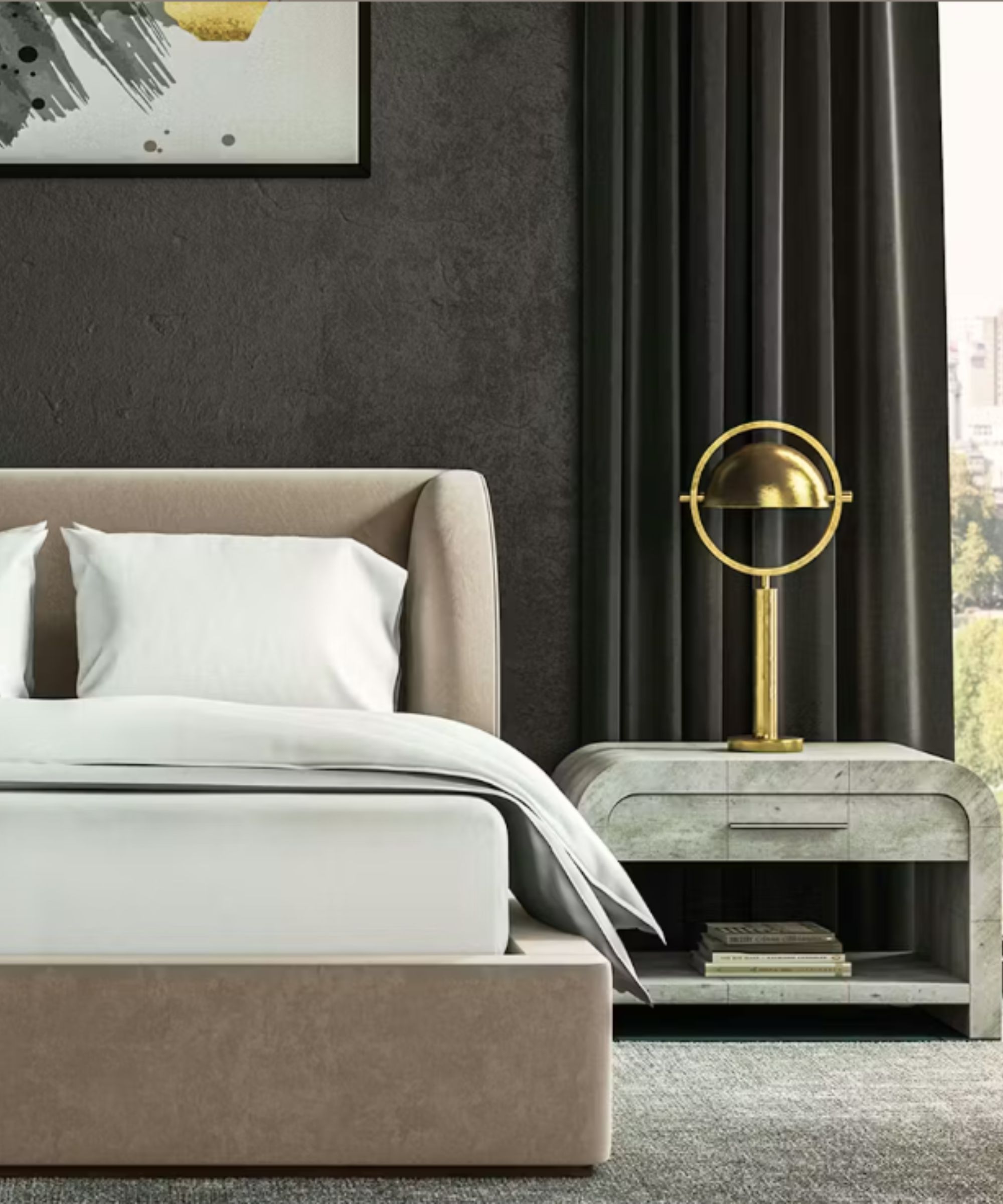
Saatva's Cassis Platform Bed Frame boasts a relaxed yet refined comfort. Its sculptural lines and low profile invite you to spend more quality time in bed.
Saatva also brings its premium sleep expertise to a curated line of bed frames that prioritize craftsmanship, material integrity, and long-lasting comfort. Each design is made to order using high-quality hardwoods, durable upholstery, and thoughtful construction that supports both the mattress and the overall sleep experience.
Best for: Premium frames and made-to-order craftsmanship
Lead time: Typically 2–4 weeks
Price: $$–$$$
Thuma

This cozy modern bedroom proves that Thuma's Essential Bed Frame is all you need to create a luxurious looking bedroom.
Thuma has become a cult favorite for its minimal, Japanese-inspired bed frames that pair craftsmanship with modern convenience. Their signature design, named The Classic Bed, is built with real upcycled wood, double-strength slats, and a tool-free assembly that takes minutes, not hours. Their aesthetic is warm, natural, and unfussy, appealing to design lovers who value quality materials and thoughtful construction.
Best for: Minimalist design, sustainable materials, and easy assembly
Lead time: Typically 1–2 weeks, depending on finish and size
Price: $$–$$$
Affordable Finds
Good design doesn’t have to come with a high price tag. These retailers offer well-made, stylish bed frames that balance look, comfort, and value – all without compromising on the essentials – making it easy to refresh your bedroom with pieces that feel considered and current, even on a budget.
The Home Depot

One of Home Depot's standout bed designs, the Marsden Patina Wooden Cane Bed is a budget-friendly way to create a cabin or cottage-style space.
The Home Depot offers a surprisingly robust selection of budget-friendly bed frames, ranging from simple metal designs to storage solutions. It’s a great destination for practical, easy-to-assemble styles that suit guest rooms, first apartments, or quick refreshes. With thousands of options online, frequent promotions, and reliable delivery, this is an easy and affordable option. Plus, when you shop at Home Depot, you can pick up any tools you need to assemble your bed frame in one order.
Best for: Budget-friendly basics, sturdy frames, and storage styles
Lead time: 3–7 business days for in-stock items
Price: $
Amazon
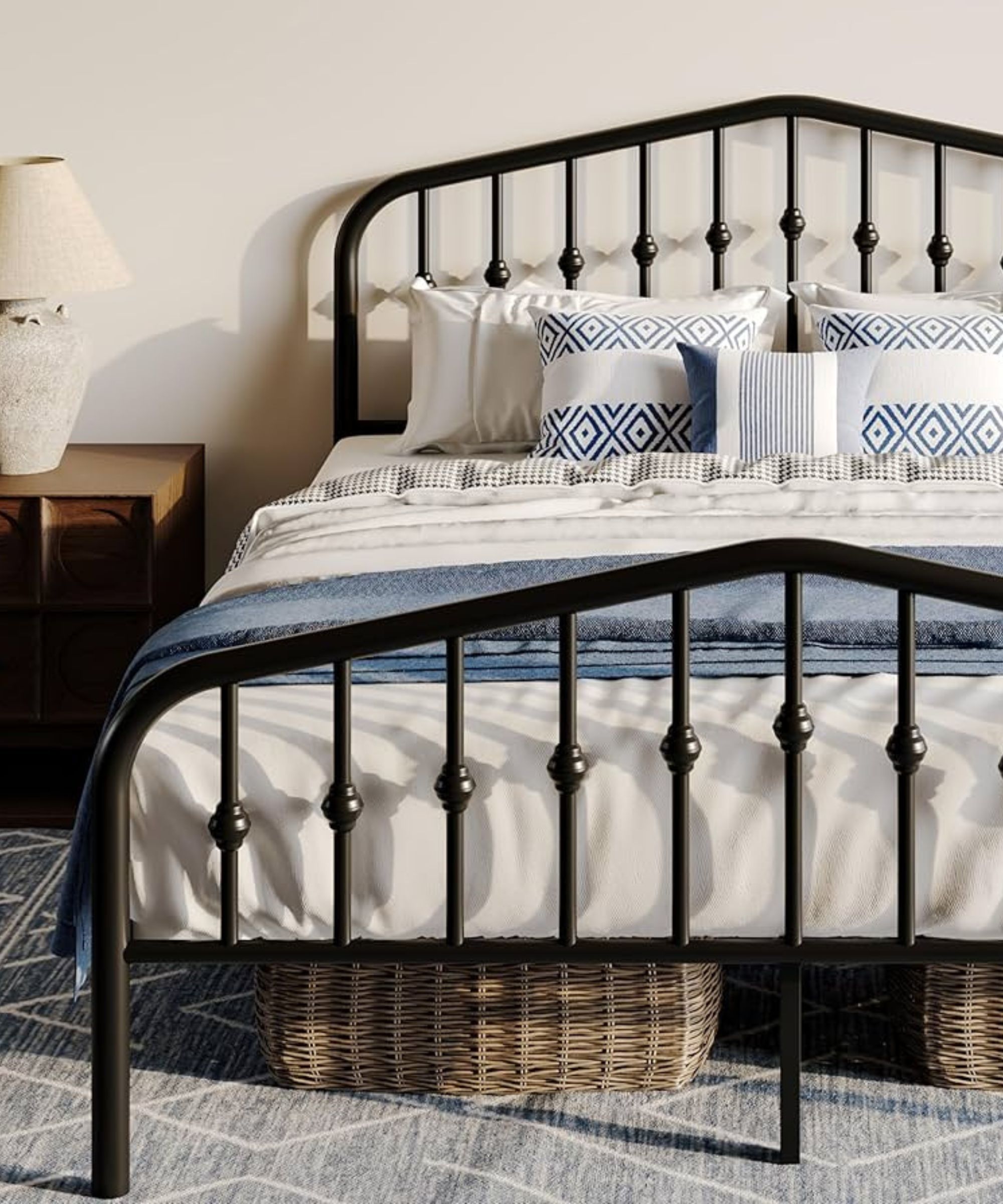
Amazon's WEEWAY Metal Platform Bed Frame is a surprisingly stylish hidden gem found on the vast retailer. The vintage-style wrought iron adds so much character.
Amazon remains one of the easiest places to find a wide range of budget-friendly bed frames, from minimalist bases to upholstered platforms and wood-look designs. With countless styles, fast shipping, and extensive customer reviews, it’s an ideal starting point for quick, affordable solutions – especially if you need a frame delivered fast. While the selection varies widely, filtering makes it easy to uncover stylish options at every price point. For more, take a look at our best Amazon furniture round-up for your entire home, too.
Best for: Fast delivery, budget basics, and customer reviews
Lead time: Often 1–5 days with Prime delivery
Price: $
IKEA

Simple yet effortlessly stylish, IKEA's TONSTAD Bed Frame is an affordable bed frame that ought to last you for years. You'll need to add the LÖNSET Slatted Bed Base too.
IKEA is a go-to for stylish, functional, and wallet-friendly bed frames that hold up surprisingly well over time. Their Scandinavian designs prioritize clean lines, smart storage, and easy customization – perfect for small bedrooms, kids’ rooms, or minimalist interiors. With options ranging from simple metal frames to solid wood and upholstered or slipcovered beds, IKEA delivers dependable quality at prices that make upgrading your bedroom feel effortless. The MALM collection is a best-seller for simple storage pieces.
Best for: Scandi style, smart storage beds, and great value
Lead time: Typically 3–10 days for delivery; same-day pickup available in stores
Price: $
Wayfair

Birch Lane's Verona Upholstered Slipcover Bed is available in a myriad of beautiful prints and fabrics, including this preppy stripe, to suit a farmhouse or cottage bedroom.
Wayfair offers one of the largest selections of affordable bed frames online, making it incredibly easy to find a style, material, or silhouette that fits your space and budget. From simple styles to upholstered statement beds and wood frames in every finish, Wayfair’s range is broad, accessible, and often surprisingly stylish. Frequent sales, fast shipping, and an abundance of customer reviews make it a reliable one-stop shop for budget-conscious decorators. Birch Lane, Joss & Main, and Stoffer Home are some of our go-tos.
Best for: Huge variety, fast shipping, budget-friendly styles, and frequent deals
Lead time: Most items ship within 1–3 days; delivery typically 3–7 days
Price: $–$$
Our Favorite Beds to Shop Now
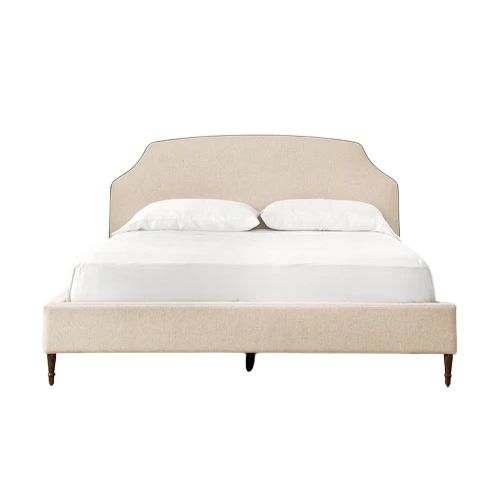
The Willoughby Bed captures Shea McGee's signature blend of timeless, quiet luxury style. Its soft, sculpted silhouette and gently curved headboard (complete with striped trim) bring an elevated look, while the turned English oak legs add heritage charm. Finished in a neutral linen that feels both versatile and refined, this design offers classic appeal with just the right amount of added detail.

Romantic and expressive, the Bowen Bed is a standout for pattern lovers. Wrapped in a delicate floral print and finished with a full ruffled skirt, it brings a soft, cottage-inspired aesthetic to any bedroom. Influenced by Italian design, the playfulness of this bed frame allows you to create a statement scheme with this as the centerpiece.

Modern and simple yet effortlessly sophisticated, the Estelle Bed pairs a clean-lined metal canopy with a plush linen headboard for a balanced look. The hand-crafted frame adds subtle decorative detailing, while the mixed materials create a high-contrast finish that feels both fresh and timeless. It’s a stunning statement piece for a primary bedroom.

Designed in collaboration with Aimee Song, the Neve Bed brings her beloved personal style into the bedroom. The sculpted headboard and supple upholstery give this platform bed a fashion-forward edge, while its simplified curved form keeps it grounded and comfortable.

For coastal or cottage fans, the Barlow Bed is a real statement. Hand-woven from 100% rattan, it brings warm, Cali casual character with a sculptural headboard to complete the look. The natural weave and softly arched profile add warmth, while the solid wood frame ensures lasting stability. Perfect for creating a breezy, resort-inspired bedroom.

The Allis Bed blends classic charm with customizability, featuring a softly arched headboard and subtle wingback silhouette for a refined yet inviting look. Its cotton-blend upholstery comes in multiple colors and pattern options, allowing you to tailor the piece to your bedroom’s palette. With its handcrafted structure and approachable price point, it’s an excellent way to add personality without the splurge.
FAQS
How Do I Choose a Bed Frame?
A bed frame is a big purchase and one that you want to last through years of use. That's why it's so important to try and get it right the first time. Here are the key considerations to keep in mind when you're shopping.
- Define your style: a sleek metal bed frame looks stark and modern, where wood feels a little warmer, and upholstery adds a sense of luxury. A platform bed is a classic for a reason, while a four-poster is more romantic. A sleigh bed cuts a dramatic silhouette, but might crowd a smaller room, while a low-slung bed frame might look out of place in a primary bedroom.
- Shop for special features: consider the look and layout of your bedroom. If you're working with a small space, you could shop for a bed frame with in-built storage. Some bed frames feature low platforms that double as nightstands, while others come with in-built USBs for easy charging.
- Consider added extras: before I bought my first bed frame, I had no idea that headboards are sold separately. If you're looking for something super minimal or monastic, you could forgo a headboard and just buy the bed frame. You only need to buy a headboard if you want the additional head support or style statement.
- Set your budget: a good bed frame could cost anywhere from a couple of hundred to a few thousand dollars. Before you start shopping, I recommend you fix an upper and a lower limit to your budget. Personally, I would never spend less than $500 on a bed frame, but that's because I prefer the solidity of wood to the streamlined look and feel of metal. I wouldn't spend more than $1,500 for a Queen, but you could easily exceed that limit if you're shopping for plush fabrics and pretty prints.
How Long Should a Bed Frame Last?
If you take good care of it, a bed frame can last for generations. My parents have been sleeping on the same wooden bed frame since they got married in the 90s, and that was handed down from my dad's grandparents, who first bought it back in the 50s.
When your bed frame ceases to be supportive, it's time to buy a new one. Watch out for excessive creaking, split wood, bent slats, and signs of irreversible, uncomfortable wear and tear.
Do I Need a Box Spring?
Whether you need a box spring depends on the type of bed frame and mattress you own. Most modern mattresses – including memory foam and hybrid styles – are designed to sit on a solid or slatted foundation rather than a traditional box spring.
You may need a box spring if you have a metal bed frame that lacks built-in slats, or if you prefer a taller bed height.
If your bed frame includes closely spaced slats, a solid platform, or adjustable base compatibility, you likely don’t need a box spring at all.
Simply put, not all bed frames need a separate box spring, but some do. It’s always best to check with your retailer in store or online.
What is the Best Bed for a Small Bedroom?
When reconfiguring a small bedroom, forward planning is essential to ensure your furniture and decor really maximize every inch of available space. Space is at a premium in small rooms, so investing in a storage bed – like one with drawers or an ottoman where the mattress lifts up to reveal a large storage space underneath – is a worthwhile investment
Many bed designs now come with two drawers on each side, providing the perfect place for extra bedroom storage. And, if you don't like the look of the drawers, you can always add a valance for extra style.
A footboard is a nice addition for larger, grander bedrooms, but it can feel bulky when it comes to small bedrooms, taking up all-important space. Lucy St George, Co-founder of Rockett St George, says: 'When choosing a bed for a small room, do not get a bed with a footboard, it will overpower the space and make it harder to move around the room. But just because you should eschew the footboard doesn't mean you can't embrace statement headboard ideas,' says Lucy.
'Beds for small rooms with a striking headboard can be a great replacement for above-the-bed decor, especially if you are in a rented property. Don’t be afraid to be playful with shape. A headboard can be used to become the centerpiece of your space.'
You can also look to nook beds for custom inspiration ideas that tuck perfectly into your space, provide hidden storage, and oodles of design opportunity.
Design expertise in your inbox – from inspiring decorating ideas and beautiful celebrity homes to practical gardening advice and shopping round-ups.

Charlotte is the style and trends editor at Homes and Gardens and has been with the team since Christmas 2023. Following a 5 year career in Fashion, she has worked at many women's glossy magazines including Grazia, Stylist, and Hello!, and as Interiors Editor for British heritage department store Liberty. Her role at H&G fuses her love of style with her passion for interior design, and she is currently undergoing her second home renovation - you can follow her journey over on @olbyhome